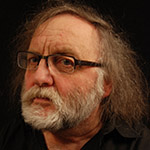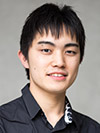Toru Takemitsu Composition Award
4 Finalists selected for Toru Takemitsu Composition Award 2022
[Judge: Brian Ferneyhough]
02 Dec, 2021
Brian Ferneyhough, judge of the Toru Takemitsu Composition Award 2022, has chosen the following 4 orchestral works out of 79 entries from 27 countries (Countries & Regions) eligibly accepted by 30 September 2021. Screening was done with the anonymous scores having only their titles.
These 4 nominated works will be performed on 29 May 2022 at the Tokyo Opera City Concert Hall : Takemitsu Memorial for Mr. Ferneyhough’s final judgement. Here is the list of finalists in order of their entry.
Applications for 2022(PDF/137KB)
- Year 2022 Brian Ferneyhough (United Kingdom)
-

© Colin Still
Finalists (in order of entry)
Omar Hernández Lazo (Mexico)
Inflamado de una álgida lejanía
Born in Mexico City, Mexico in 1989. He began his professional training in guitar and composition with Josué Amador to later complete a degree in composition at the Escuela Superior de Música with José Luis Castillo; in parallel he studied with Germán Romero and Samuel Cedillo. He has a particular interest in the poetics, materiality, forms of production and social practices of music and sound. His works have been performed by musicians such as: Wilfrido Terrazas, Othoníel Mejía, Ensemble Limiar, Arditti Quartet, Ensemble CEPROMUSIC and Ensemble Ars Nova.

Mehmet Ӧzkan (Turkey/Bulgaria)
Intermezzo for Orchestra "Anarchical Lament"
Born in Kardzhali, Bulgaria in 1987. He started his music education after the settlement of his family in Turkey. He was accepted to the piano department at Uludag University State Conservatory. After graduating from the piano department he studied composition at MSGSU State Conservatory. His many different chamber musics and orchestral works have been performed many times in Turkey, Russia, Germany, Belgium, Thailand, Bulgaria. His piece for symphony orchestra and baritone "Lunatic’s Lay" was made it to the finals in 9. Dr. Nejat F.Eczacıbaşı Competition. He is currently lecturer at ITU Turkish Music State Conservatory.
http://www.mehmetozkan.site/

Andrea Mattevi (Italy)
Comune il principio e la fine del cerchio for symphonic orchestra
Born in Treno, Italy in 1986. He is composer and violist. His music has been performed by Mivos quartet, Basel Sinfonietta, Cracovia Sinfonietta, MDI Ensemble, L’arsenale, Alter Ego Ensemble, Dédalo Ensemble, Ensemble Windkraft, Interensemble, Ensemble AdM Soundscape, and others, receiving commissions from the Orchestra Haydn di Bolzano e Trento Foundation and others. He carries out an articulated artistic performance activity as soloist and in chamber formations and in the orchestral context, collaborating with the Orchestra Sinfonica Nazionale della RAI, Petruzzelli Theater Orchestra and many others. His music is characterized by the emergence of different coexisting temporal layers and by a structured juxtaposition of sonorities and texture that seek an expressive brightness.

Takuto Muromoto (Japan)
KEBESU - Circle of Flame for orchestra
Born in Kyoto, Japan in 1997. He is currently a student at Tokyo University of the Arts (Master Course). In 2020, his work was performed by the Flux String Quartet, produced by Toshi Ichiyanagi. In the same year, he was selected for the 37th JSCM Award. In 2021, he won the third prize in the composition section of the 90th Japan Music Competition, and in 2022, he was selected for the 11th JFC Composition Award. He has studied composition with Ryota Hiramatsu, Keisuke Ogura and Jummei Suzuki. His works have been performed by the Geidai Philharmonia Orchestra, the Tokyo Philharmonic Orchestra, the Flux String Quartet and the Ensemble Intercontemporain.

Comments for the Final / as a single judge
for the Toru Takemitsu Composition Award 2022
Being conscious that there can be no single unassailable set of criteria in the judging of works of art I examined all submitted scores twice before engaging with the preliminary selection process, thus assuring myself of a wide contextual perspective. At this point I began a third reading with a view to whittling the original total of almost eighty scores down according to criteria I will enumerate below. This was an intense process in that the general quality of submitted scores with respect to their idiomatic employment of the orchestral apparatus was very high. After this third reading a dozen outstanding scores remained. I sat for a week with these works on my desk before progressing further, since each piece demanded to be evaluated according to its unique qualities.
In making my final selection I have tried to find a balance between (1) degrees of performative difficulty (2) originality of concept (3) skill and imagination in sustaining and exploiting the given materials and, lastly, something very hard to define, namely 'individuality'.
- As regards the first of these criteria I noted that the majority of submissions, while remaining by and large within what might be considered ‘normal’ techniques, nevertheless imposed severe demands on the performers by reason of consistently high degrees of virtuosity required throughout. This was true most often in the strings, where complex material was made more difficult by the requirements of unison figurations more appropriate in chamber music.
- Originality of concept is difficult to define: in my view, however, one must be able to sense a background set of intentions over and beyond the wish to compose a ‘good’ piece. Many of the submitted works made sincere efforts to assure the listeners that some consistent and meaningful cumulative perspective was being articulated.
- A very important point, for me, is evidence of skill in extending, developing and rendering whatever initial materials are chosen in an aesthetically consistent whole. Particularly with large formations this can be challenging, and I felt that some works were not able to convincingly sustain their discourse in this manner, no matter how striking their basic premises.
- What is individuality? I can only reply that, after many years of engagement with new music, I believe that I know it when I encounter it. If the composer is convinced, it is likely that we, the listeners, will be also.
At the end of this lengthy process I chose four works from the final group which I believe exemplify, each in its own unique way, a viable combination of the above points.
I congratulate all participants most sincerely and am grateful to have had this opportunity to sample the enormous creativity displayed.
Inflamado de una álgida lejanía
A remarkable vision of total fluidity in motion, daring the listener to undertake speculative ordering constantly fated to be frustrated by the intervention of a highly crafted haze. Perspective is an important aspect of musical experience; here the placement of the ear is annulled: instead, it is drawn inward and outward at one and the same time.
Intermezzo for Orchestra "Anarchical Lament"
I was very taken by the robust, strident and self-confident voice of this piece. Sometimes the issue of formal coherency is best approached from its opposite pole, namely the very specific discontinuity of non-sequitur which is here pitilessly enunciated. The risks associated with this strategy are evidently enormous since every rude break in the facade faces the composer anew with the same vacuum of meaning to be overcome in the battle for survival.
Comune il principio e la fine del cerchio
This work impressed me by the very lightness with which its evident discipline is communicated. By these means unexpected situations are brought in ‘by the back door’ and do not need to insist embarrassingly upon their expressive presence. Formal dimensions are presented by their immediate generative consequences, not oppressively imposed. The orchestra is delicately taken apart and analysed into a series of glittering images like intersecting patterns on tiled floors.
KEBESU - Circle of Flame
I admired here an approach to the orchestra which succeeds in treating it not as a group of potential individual resources but as an organic whole in which players are able to understand and project their contribution in the controlled flow of the entire ensemble. I discern a sense of legitimation of individual textural strata, even when, as is often the case, multiple strands of activity are superimposed. As a result there emerges a fascinating sense of functional translucency.
Brian Ferneyhough
Final Concert
15:00, Sun. 29 May, 2022
Tokyo Opera City Concert Hall: Takemitsu Memorial
[COMPOSIUM 2022]
Toru Takemitsu Composition Award 2022: Final Concert
Brian Ferneyhough, judge
Yasuo Shinozaki, conductor
Tokyo Philharmonic Orchestra
Contact us
Tokyo Opera City Cultural Foundation
3-20-2 Nishi-Shinjuku, Shinjuku-ku, Tokyo 163-1403 JAPAN
Tel. +81 3 5353 0770
Fax.+81 3 5353 0771